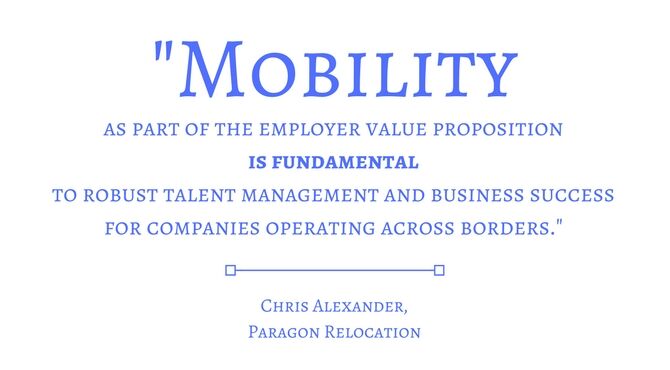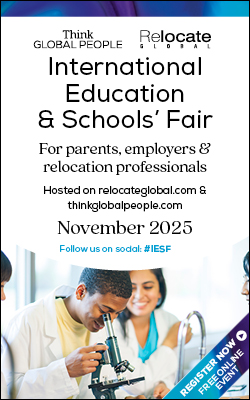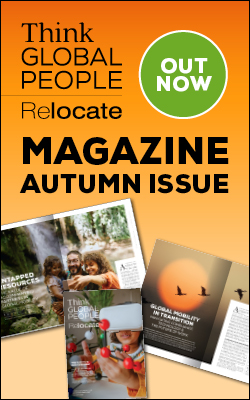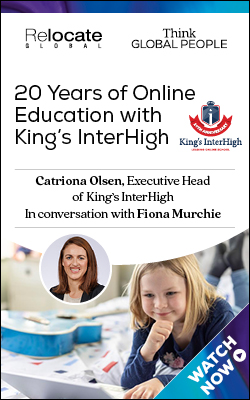Aligning mobility with talent management: how to seize the moment
A confluence of business, social and people management trends is giving global mobility a ‘golden moment’ to align more closely with talent. Chris Alexander, of Paragon Relocation, explains.

Why the change in emphasis?
For many, the model to aspire to in response to these changes is a seamless, fully integrated, and more automated global mobility (GM) function.Data shows that, although relatively late to the party, mobility professionals are increasingly using predictive workforce analysis. Of the 100-plus respondents to Deloitte’s Global Mobility Insights: 2016 Outlook, 73 per cent reported GM technological improvements of some kind.A third (32 per cent) of respondents said that GM was involved in business transformation. Companies at the leading edge are working across teams and are an integral part of making the business happen, to budget and strategic objective.A raft of mobility industry data looking at initiatives for the next 12 months suggests that process optimisation and global mobility staff development will be a continued primary focus for many companies. Going forward, GM should spend more time partnering strategically with the business and talent teams and less on process activities, which are now more easily automated.Joint research from the Canadian Employee Relocation Council (CERC) and the European Relocation Association (EuRA) indicates the scale of both the opportunity and the challenge. Nearly eight out of ten employers (78 per cent) expect to change the way in which they manage talent in the short to medium term.We know there is a strong appetite for international mobility. According to more joint research, this time professional services firm EY and the Harvard Business Review’s (HBR) Strategic Global Mobility: Unlocking the Value of Cross-border Assignments, new market growth is the principal driver for global mobility (60 per cent).Exemplifying the value of mobility for talent attraction, the second top reason is increased demand from candidates for cross-border assignments (36 per cent).The time is therefore right for more global mobility teams to capitalise on business transformation and align strategically with the talent team – those who are also responsible for the attraction, recruitment, deployment and retention of people with in-demand skills and expertise.Types of international assignment, and trends
The need for global mobility has increased by 63 per cent in the past three years, according to the EY/HBR study of 695 global companies. The study’s respondents also anticipate more demand over the next two to three years.The range of assignment opportunities has increased hugely, by type and destination. Alongside the traditional three-to-five-year move, which remains significant, professional services firm PwC’s data suggests that short-term assignments of a year or less now comprise 20 per cent of assignments. This compares with 10 per cent in 2002.Rotational employee development assignments, commuting and business-travel arrangements, together with project-based moves, are adding to the mobility mix. From a policy perspective, these are supported with an evolving array of packages, from local, local-plus and heavy local to expatriate.Related articles:
- Self-initiated moves in the gig economy
- The global mobility agenda: current trends
- How global businesses can harness LGBT talent
Progress to date: what’s working well …
The range of assignment types, and Deloitte’s continuum, show the progress mobility is making in addressing business needs.Mobility’s ready adoption of outsourced expertise for core administrative and technical processes means that the function is already adept at working across disciplines and managing teams inside and outside the organisation. GM also benefits from the economies of scale offered by outsourcing, which can be taken forward into the talent arena.The past few years have underscored companies’ absolute requirement to be responsible and compliant. Working with expert partners, and embedding that relationship, is another of the outsourcing success stories and mobility can reflect internally.The technological advances now available to GM mean that the function can be proactive and predictive with the information it holds, and partner more effectively with the business. This is a pivotal moment for GM to be involved with the transformation process and move out of the silos that endanger strategy delivery.Mobility has a key role to play in workforce planning and forecasting, particularly around new business and in M&A. GM has the capacity to use its expert compliance and policy knowledge to segment mobile workforces and opportunities by key assignment roles. Workforce data enables mobility and talent teams to match people to places and identify additional training, development, talent pipeline and recruitment needs.… and what isn’t working well
Yet, according to Deloitte’s Global Mobility Insights: 2016 Outlook, the greatest barrier to GM’s taking a more central and aligned role is the perception of its remit as operational rather than strategic (57 per cent). The next perceived challenge (42 per cent) is GM’s capacity and willingness to engage with other teams.Social transformation is an area in which mobility can also up its game. We have known for some time that big changes are afoot in the workplace. More women and people with eldercare responsibilities, fewer younger workers, and an ageing workforce are some of the familiar themes.Current approaches to both talent management and mobility are apparently failing to include fully people of all backgrounds and genders. HR consultant Mercer finds that over 85 per cent of small and medium-sized companies struggle to find the right candidates for assignments.Perhaps in response, CERC/EuRA data shows that 71 per cent of respondents are actively searching for talent in different geographies, industries and demographics.However, insights into who goes on assignment tell an overwhelming story that methods so far are failing to deliver greater diversity. Various mobility industry data confirm that only around a quarter of the assignee population is female, for example.Similarly, a Harvard Business Review report shows that current measures to identify high-performance talent (HiPo) – often those identified for overseas assignments – are frequently misguided. Researchers assessed the performance of 42 per cent of HiPos as actually below the average.The so-called gig economy – a series of short-term roles with looser employment ties – also has the potential to transform the workforce. EY reports that two in five organisations expect to increase their use of ‘contingent workers’ by 2020.A similar number do not have confidence they can manage this burgeoning demographic, particularly when employment laws are struggling to keep up. This raises significant questions around the employment relationship and duty of care in the talent mobility space.By sharing knowledge and insights, talent and mobility teams have the opportunity to align more closely with the business and capitalise on wider social changes. If we know from predictive data analytics what skills we need, where to find them, and how best to manage them from a policy and budget perspective, mobility can be used overtly as part of employer brand in recruitment.Why don’t more companies use international assignments as a recruiting tool?
According to the EY/HBR study, despite the evolving nature of international assignments to keep pace with business need, the top challenges of global mobility deployment remain ad hoc approaches, the high expense of relocation, the skills gaps created by moving a talented manager elsewhere, and a lack of ownership of mobility among senior executives.It seems that, despite the strides mobility has made towards rising to the challenge of more and more diversity, the underlying challenges remain the same. The lack of available talent and understanding of mobility’s role in nurturing it are actually holding back greater alignment, when, in fact, this is what would allow us to move on.Related articles:
- Self-initiated moves in the gig economy
- The global mobility agenda: current trends
- How global businesses can harness LGBT talent
What would companies gain by using international assignments as a recruiting tool?
Some big employers already recognise the value of exposing people to opportunities globally. They make this explicit in their recruitment propositions, and back it up in practice with line-manager involvement.Today, mobility as part of the employer value proposition is fundamental to robust talent management and business success for companies operating across borders.This moves mobility’s role firmly into the realm of strategic talent management, building talent pools, and retaining people by addressing skills challenges, developing talent internally, and monitoring data.Adding further insight from EY and HBR, the dream-team of talent and mobility helps businesses to address key issues of market complexity, speed to market, and global reach. Their study found that global mobility programmes in the companies studied “have been critical to supporting new business growth, improving financial performance, bolstering employee engagement, succession planning, retaining and developing top talent, and increasing diversity.”Five steps to success to align mobility with talent more strategically
How can mobility practitioners take the next steps to align mobility with talent and make mobility count in attraction, recruitment and retention?- One of greatest blocks to mobility’s taking a more central and aligned role is the perception it is operational rather than strategic.
Explain to talent leaders how data-based mobility can be critical in creating an agile business and engage with all stakeholders. Use your company-wide HR contacts in multisite operations to engage, listen and commit to making changes. - Workforce analytics, talent mapping and workforce planning are game changers.
Use the tools available to you, and ask your GM colleague networks and outsourced providers for insight and advice. Know the problem you are trying to solve, and start small. - Involve mobility and talent in the discussions around new business, projects and business transformation.
Demographic trends, skills, cost and compliance issues are not going away, and people are a key source of competitive advantage. Make sure you and your talent partners demonstrate this. - Look at your data, and be honest about where your mobility policies could be improved to align with the recruitment and career offer.
Are assignments successful? On what measures? What does post-assignment retention say about how the assignment lifecycle is managed? What are the cost and compliance implications? Do people stay?
Look at the data by age, gender, level of qualification, job role, and so on. What is the role of third-party providers? Can they help? What insights can you share with talent teams, and vice versa? - Leadership and employer value propositions are a key part of employee attraction, recruitment and retention. This has to follow throughout the business and with leadership, line manager and policy support.
Work with talent colleagues to engage with line managers so that everyone has a stake in making talent mobility work properly. Showcase stories, and add data to make your case.
Policy considerations for successful international assignments
Clearly, talent mobility policies often vary according to sector, host and home countries, and cost considerations. However, there are some overall themes that can help embed strategic talent mobility through policy into practice.- Be clear about what the policy is designed to achieve, and make sure that supporting processes align so that relocated employees are treated as core assets. The policy should also reflect the aims and objectives, values and purpose of the company.
- Make sure that talent attraction campaigns and selection processes access the widest possible candidate pool. Panellists on global HR consultant Mercer’s annual When Women Thrive discussion at this year’s World Economic Forum in Davos argued that talent management teams had a key role in removing screens to talent – for example, by introducing name-blind recruitment and pre-application assessment for gauging alignment between personal and corporate values.
Also, only seeking graduates misses out on highly skilled employees who have come through the more technical apprenticeship route. Screening employees who express an interest in overseas assignments for their aptitude to do so, and keeping up to date with their career aspirations, can also increase the pool of mobile talent. - Support more diverse talent pools by offering a tiered, core-flex approach to assignment packages. This enables assignees to choose elements according to personal need (schools, immigration, home search or home leave, for instance), improves the likelihood of assignment success, and maximises the value of the package to assignees.
- More companies are favouring local approaches to pay alongside tiered packages in the interests of equity with local talent and more employee-driven moves.
Benchmark packages independently on a regular basis, to ensure the company is getting value for money and the employee a competitive package. This will help contain costs and support retention. - Consider having policies for self-initiated moves, and frameworks to assess candidate suitability. This allows employees to match their personal and work circumstances. Self-initiated moves are likely to be a key talent-retention tool for Millennials in the future.
- Enshrine career-development commitments in policy. This could cover how the line manager and the assignee can expect to keep in touch and prepare for repatriation, including career-development prospects. Keep this conversation open. Talent swaps can be very useful for intra-company learning, and to plug skills gaps.
- Explain and communicate the policy internally through the intranet and conversations with line managers, coaches and mentors, and senior leaders.
Consider running internal communication campaigns to generate interest and promote the contribution of talent mobility to company success. This could add to the pool of talent and demonstrate, both internally and externally, your company’s reputation for its commitment to talent mobility.
Conclusion
This confluence of business, social and people management trends means that global mobility has a golden moment to align more closely with the core talent management policies. Mobility’s role in talent attraction, recruitment and retention is valuable, yet overlooked.There is now a real chance, with data analytics for mobility professionals, to make the case and move to align more closely with talent, closing perception and the skills gaps in the process.For further information about Paragon Relocation and its services, visit paragonrelocation.comParagon Relocation is a full service, global relocation management company (RMC) and has been providing services for over 25 years. True to its consulting origins, Paragon distinguishes itself by leveraging policy and program design to achieve business goals, including aligning Mobility with Talent Management, cost savings, increased management capability and higher employee satisfaction for its clients. For more information, please visit paragonrelocation.com Click here to visit Paragon Relocation's Facebook, LinkedIn and Twitter pages.Email: info@paragonrelocation.comRelocate magazine's Spring 2017 issue is available online.Access hundreds of global services and suppliers in our Online Directory.
 Get access to our free Global Mobility Toolkit
Get access to our free Global Mobility Toolkit 






























